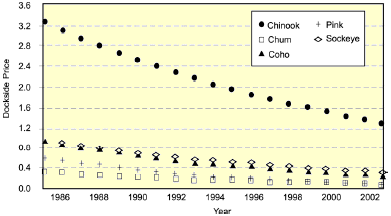Abstract
We use a simple conceptual model to highlight the challenges that Alaskas wild salmon industry must overcome before the industry is likely to see significant revenue gains from increased quality. Our tentative conclusion is that product differentiation could increase profits for wild salmon. However, implementation may require significant departures from traditional production and management practices and possibly an amendment to the Alaska state constitution.
I. Introduction
In 1980, 1 percent of the world salmon supply was farm raised. The share of farmraised
salmon produced worldwide rose to 32 percent by 1992 and exceeded 60 percent
in 2002. Wild salmon production during this period remained relatively constant because
of limitations imposed by the carrying capacity of the ocean environment. Consequently,
the share of world salmon production from wild Alaskan fisheries has declined
considerably over the last 20 years. From 1985 to 2001, world salmon production
increased from 8.5 million metric tons to 16.9 million metric tons while the Alaskan
market share declined from roughly 35 percent to 19 percent.
The dramatic increase in world salmon supply has been accompanied by significant
price declines. As shown in Figure 1, dockside prices in Alaska dropped 0.86 percent per
year from 1985 to 2000. Industry revenues in 2002 were $141 million, roughly 38 percent
of the average revenues received in the 1990-1995 period. Not unexpectedly, industry
changes, particularly reduced fishing income, have raised serious concerns in the state.
State and local governments, industry, and Alaskan residents accept the presence of
farmed salmon in world markets. Lingering hope that pressure from environmental
groups would lead consumers away from the farmed product has all but disappeared.
Regulators and industry must decide whether to accept the decline in the Alaskan wild
salmon industry or to devise strategies to revitalize it. One strategy under consideration is
to differentiate wild salmon from farmed salmon and to devise new plans for production,
marketing, and promotion to deliver a superior-quality product to consumers. If
consumers perceive a difference between wild and farmed salmon, perhaps they could be
induced to pay a price premium for wild salmon that could increase industry revenues
and revitalize the industry.

The natural logarithm of annual average dockside price is regressed against total
harvest quantity (which is fixed by regulators) and a linear trend. A system of five
equations was specified using data from 1984 to 2002. Iterated seemingly unrelated
regression is used for estimation. Fitted price trends are evaluated at the average harvest quantity.
In the remainder of the paper, we discuss the challenges facing the salmon industry
and regulators in carrying out a strategy to differentiate wild from farmed salmon. In
Section II we describe quality considerations in salmon, including intrinsic and extrinsic
characteristics. In Section III we present a conceptual model of decision making in the
salmon industry to demonstrate the problems that must be overcome by the wild salmon
industry as it tries to compete with farmed salmon.
Wild Alaskan salmon are harvested from remote waters, often in dangerous weather conditions, under strict regulatory controls, and during a shortened pre-spawning period when salmon congregate at the mouths of the rivers of their birth. In sharp contrast, farmed salmon are harvested year round, or in response to consumer demand, from enclosures that have been strategically located near transportation routes.
In Section IV, we discuss proposed solutions to the problem of the difficulties of
creating required incentives to increase quality, followed in Section V by a discussion of
whether consumers really will pay more for wild salmon. Salmon are highly perishable, and price premiums are unlikely if consumers do not see and taste a superior quality product. Despite less-than-ideal conditions, steps to improve the quality of the wild salmon product are available and are being implemented in some segments of the industry.
Remaining challenges, highlighted in Section VI, concern the regulatory environment and, more fundamentally, the historical, cultural, and constitutional nature of the Alaskan salmon industry. The industry continues to struggle with regulations designed to address overexploitation and overcapitalization that plagues common property resources such as fisheries. Alaskan regulations unnecessarily raise harvesting costs and exacerbate uncertainty. The constitutional requirement that Alaskan fisheries resources be accessible to all Alaskans further magnifies these problems.
Conclusions and recommendations are given in Section VII. Despite the many challenges facing the industry, quality improvement, marketing, and regulatory changes could pay dividends for the Alaskan salmon industry.
To view the full report, please click here (PDF format, 26 pages)
Source: Center for Agricultural and Rural Development, Iowa State University - April 2004



